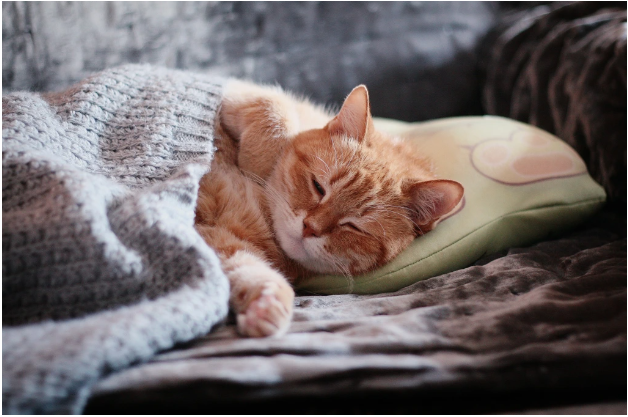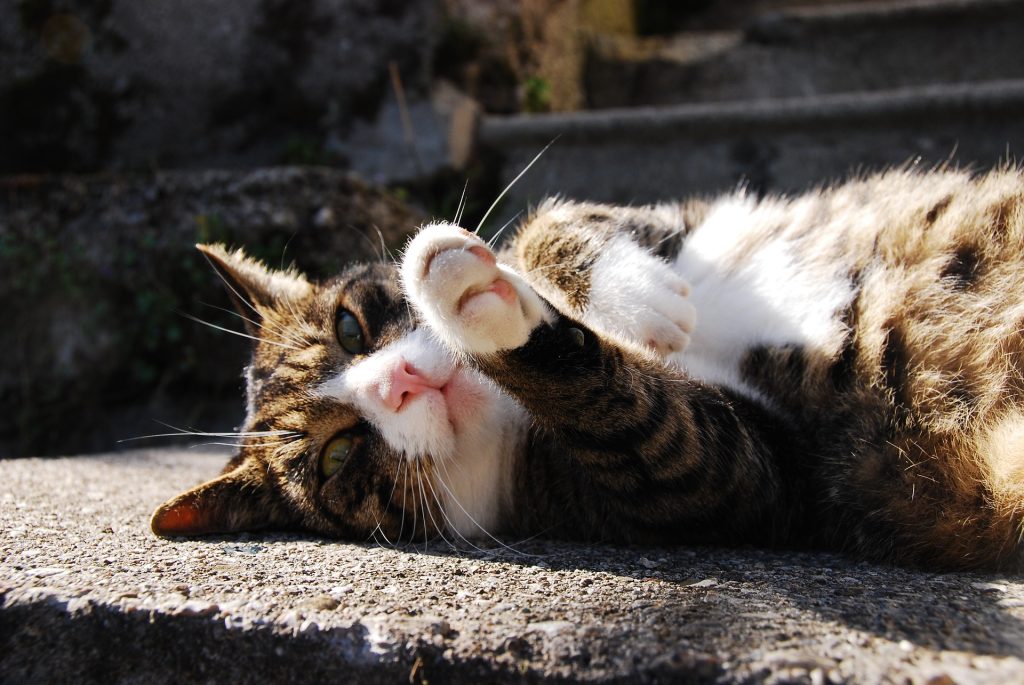For a cat, too, winter brings some changes. If you want to make sure that your cats have everything they need during cold weather, you should definitely know the answers to the most important questions about keeping cats in winter.
Table of Contents
1. Do cats get cold in winter?
Yes, cats can suit too. But connective tissue and fatty tissue protect the paws from the cold and if your cat is outdoors, it has a thick winter coat that keeps it warm. Depending on the breed and individual, cats can withstand the freezing temperatures as low as minus 20 degrees .
But beware: every cat freezes in winter in icy temperatures or at the latest when it gets very wet. Early detection of dangerous hypothermia in cats can be life-saving.
Also: kittens under the age of six months should never go out in the snow – they still lack the warming undercoat and the water-repellent insulation of the fur blanket.
If you want to make your cat really comfortable, a self-heating blanket will help . It reflects the cat’s body heat and keeps it cozy, warm and dry.
2. Can cats catch a cold?
Yes, cats can catch a cold too. Drafts, viruses or bacteria are possible triggers. Cats with a cold should not be allowed outside and should be checked out by a vet. It is therefore important that you recognize the symptoms of a cold in cats .
Caution: You can get infected from your cat with a cold . It is therefore better to keep your distance if your cat is showing symptoms of a cold.
3. Should cats be given less freedom to roam in winter?
No, it doesn’t have to be. Cats usually do well in the cold as long as they have ample opportunities to warm up in between . Your cat knows best whether to go outside in the winter or whether to snuggle up at home. Don’t force them to go out in the cold.

4. Do cats sleep more in winter?
Yes, cats exhibit winter fatigue . Cats typically need up to 16 hours of sleep a day . In winter weather it can also be 22 hours. So that the muscles don’t break down and the layer of fat doesn’t grow, you can encourage your cat to exercise more with exciting game ideas .
With a cozy cat bed you ensure a relaxed cat sleep.
5. How do cat owners properly heat and ventilate in winter?
If there is a lot of heating, the air is very dry, so that dandruff can develop in the fur . Brush your cat more frequently in winter to stimulate blood flow to the skin. Vegetable oil in the feed can also help.
It is also important to ensure sufficient humidity during the heating period. Handed out bowls of water or damp towels will help. They should open the windows fully every two hours . Never leave the windows tilted: there is a high risk of injury for your cat!
6. Do indoor cats get Winterfell?
Yes, but to a lesser extent. The fur of outdoor cats adapts to the temperatures so that the cat does not freeze in winter and does not sweat in summer. Indoor cats don’t change and develop fur much because their environment is always warm. However, unlike outdoor cats, they shed their hair all year round.

7. Can cats sleep outside in winter?
Yes, even in sub-zero temperatures . However, you can set up a warm spot for your cat outside so that it has a warm retreat when it doesn’t want to go into the apartment in the evening.
A small warming hut with a cozy blanket or straw offers the cat sufficient protection against the cold on icy nights.
The Rustica cat house by Kerbl * offers outdoor cats a protected retreat in the open air.
8. Is it dangerous if the cat eats snow?
No it is not. However, painful inflammation of the stomach lining (gastritis) can occur if the cat eats too much snow . If there is road salt on the snow, it can also be dangerous for the cat.
Outdoor cats can also consume road salt when grooming themselves. The consequences can be vomiting or diarrhea .
9. Do cats need to be warmed up after being outside?
Yes, you should rinse your cat’s paws with lukewarm water after being outside in the winter . Salt residues are also removed in this way. Vaseline or milking fat care for the stressed cat’s paws.
Drying off is not a must – your cat can do this on its own. A soft towel can be used to help her, if your cat allows it.

10. Can cat fur be cut in winter?
In the case of a long-haired cat that only lives indoors, the fur may be shortened somewhat. If you remove too much fur, the cat will freeze. Outdoor cats should not be clipped in winter at all .
Some breeds of cat even have “ snowshoes ”, i.e. tufts of fur between the toes that prevent them from sinking into the powdery snow. These include the Maine Coon , Norwegian Forest Cat and Siberian r .
11. Can cats find their way in the snow?
Yes, even if there is a lot of snow , cats can still orientate themselves. Familiar noises, familiar houses or trees help them. The cat’s sensitive nose continues to pick up urine marks through the snow .
Even in winter, if the snow is not too deep, cats can move quietly and hunt successfully . Provided there are still enough non-hibernating prey nearby.

12. Can cats get sunburned in winter?
Indeed yes, the reflective snow can cause sunburn in your cat. Cats with a light coat color, light ears and bridge of the nose are particularly affected. Sunburn is the leading cause of skin cancer in cats. A cat-friendly sunscreen with high UV protection can protect your cat from sunburn.
In winter, many things just work differently than in the other seasons. But if you follow these tips, you and your cat will be prepared for icy temperatures.
Cats and Snow – FAQs
Q: Do cats like snow?
A: Some cats may enjoy playing in the snow, while others may not be as fond of it. Each cat has its own preference when it comes to weather conditions and outdoor activities.
Q: How can I keep my outdoor cat warm and dry during snowy weather?
A: You can provide a shelter with plenty of insulation and a warm, dry space for your outdoor cat to retreat to during cold temperatures. This will help them stay comfortable and safe from the winter weather.
Q: What should I do if my cat’s paws come into contact with ice or snow?
A: After your cat has been outside in snowy or icy conditions, it’s important to check their paws for any signs of discomfort or injury. You can gently clean their paws and apply warmth to help them feel more comfortable.
Q: Are there any risks for cats playing in snowy areas?
A: Cats may face risks such as slipping on ice, encountering cold temperatures, or getting lost in snowy surroundings. It’s important to supervise and provide proper care for your cat when they are exposed to winter weather.
Q: How can I prevent my cat from drinking from puddles or getting wet in the snow?
A: You can minimize the risk of your cat drinking from puddles or getting wet by ensuring they have access to fresh water and a warm, dry shelter. Keeping them indoors during extreme weather conditions can also help protect them from unexpected encounters with water.
Q: Do cats need special care during snowy and cold weather?
A: Cats may require additional care during winter weather to ensure they stay warm and safe. Providing them with a cozy indoor space, plenty of warmth, and regular check-ins for any signs of discomfort can help keep them healthy and happy during the colder months.
Q: How can I recognize if my cat is feeling uncomfortable in cold temperatures?
A: Cats may display signs of discomfort such as shivering, seeking warmth, or trying to find shelter during cold weather. Paying attention to their behavior and providing warmth when needed can help address any feelings of discomfort they may experience.
Q: Are there any winter weather conditions that cats commonly dislike?
A: Some cats may dislike cold snaps, icy surfaces, or getting wet in the snow. It’s important to be aware of your cat’s reaction to different weather conditions and take steps to ensure their well-being and comfort.
Q: Can I take my cat for car rides in snowy weather?
A: While some cats may enjoy car rides, it’s important to consider their comfort and safety during snowy weather. Providing a warm and secure environment, and avoiding prolonged exposure to extreme weather, can help make car rides more enjoyable for your pet.
Q: How can I entertain my cat indoors during snowy weather?
A: You can engage your cat with indoor activities such as interactive toys, play sessions, and creating cozy spaces for them to explore. Providing entertainment and keeping them active indoors can offer a fun and safe alternative to outdoor activities during snowy weather.